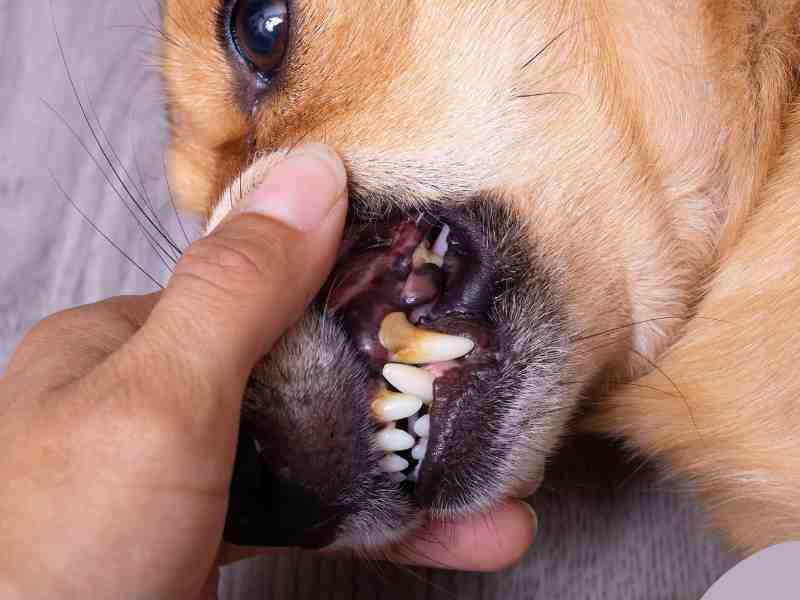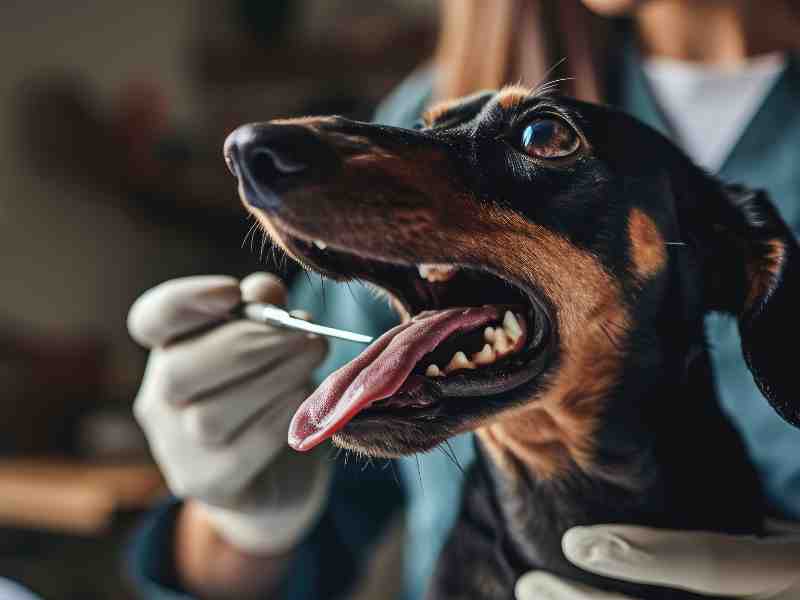Did you know that by the time they’re three, about 80% of dogs have some form of periodontal disease? It’s not just bad breath we’re talking about; it can lead to real pain, tooth loss, and even more serious health problems if we don’t catch it early. That’s why keeping an eye out for the early signs and getting ahead of the game with prevention is so crucial. After all, who wouldn’t want to keep their furry friend’s smile shining bright and healthy?
What Are The Four Stages Of Periodontal Disease In Dogs?
Periodontal disease in our furry best friends comes in stages, each marking a deeper level of concern and requiring increasing levels of intervention.
Stage 1: Gingivitis is where it all begins. At this point, the problem is still reversible. The gums might appear reddened and slightly swollen due to plaque accumulation, but the teeth are still firmly planted in their sockets, and no irreversible bone or tissue damage has occurred. Regular dental cleanings and proper home care can usually restore oral health completely at this stage.
Stage 2: Early Periodontitis marks the point where the disease starts to claim a permanent foothold. You might notice more pronounced inflammation and some minor bleeding during brushing or chewing. At this stage, slight bone loss (less than 25%) can occur, detectable only through dental x-rays. While some damage has begun, thorough dental cleanings and more aggressive home care can still prevent progression.
Stage 3: Moderate Periodontitis escalates the situation significantly. Now, we’re seeing even more swelling, bleeding, and bad breath that’s hard to ignore. Bone loss ranges from 25% to 50%, and at this stage, the gums may start receding, and teeth may begin to loosen. Treatment now requires deep cleaning below the gum line, possibly with antibiotics and other therapies to manage infection and discomfort.
Stage 4: Advanced Periodontitis is the final and most severe stage. Here, bone loss exceeds 50%, leading to significant tooth mobility or loss. The dog is likely experiencing considerable pain and may have trouble eating. Treatment options become more drastic, including extensive dental surgeries or extractions to remove affected teeth. At this point, the focus is on relieving pain and preventing further systemic health problems that can stem from severe dental disease.
Each stage of periodontal disease not only signifies a deeper level of oral degradation but also underscores the importance of early detection and intervention. Preventing progression through regular veterinary check-ups and diligent home care can save your dog from pain and protect their overall health.
Why Does My Dog Have Periodontal Disease?
So, what brings on periodontal disease in dogs? Many different things lead to dog gum disease, including lifestyle, genetic predisposition, and environmental factors, both individually and simultaneously. The main cause of problems with a dog’s oral health is a lack of regular dental care. Without daily brushing, routine dental care, and check-ups, plaque and tartar can accumulate on a dog’s teeth and get out of control. Plaque, a sticky film of food particles, bacteria, and saliva, hardens into tartar within days and sets the stage for gingivitis and periodontitis.
And while a good oral health routine for dogs is key, genetics do play a significant role in a dog’s susceptibility to periodontal disease. Some breeds, particularly small breeds like Toy Poodles, Yorkshire Terriers, and Dachshunds, are genetically predisposed to dental issues, partly due to the conformation of their mouths and the crowding of their teeth. These structural peculiarities make it easier for plaque and tartar to accumulate and harder for owners to maintain their oral hygiene.
A dog’s diet also weighs heavily on dental health. Dogs fed a diet high in carbohydrates or sugary foods or lacking in textures that naturally help scrub teeth clean are at a higher risk of developing dental diseases. While no dog food can replace the need for mechanical cleaning (like brushing or professional cleanings), diets formulated with dental health in mind may help reduce the buildup of plaque and tartar.
Of course, a dog’s overall health and age plays a part in periodontal disease. Younger dogs might bounce back quicker from early stages of dental disease, but their immune system’s ability to fend off bacteria from plaque decreases as they age. Additionally, chronic illnesses like diabetes can exacerbate their risk and severity of periodontal disease, which makes it even more important to care for their oral health.
When it comes to how to prevent gum disease in dogs, understanding these contributing factors is essential. Paying attention to your dog’s oral health care, diet, and understanding breed-specific risks may help reduce gum disease in dogs.
What Are The Signs Of Periodontal Disease In Dogs?
Recognizing the signs of periodontal disease in dogs is important for catching the condition early and preventing its progression into more severe stages. Initially, the symptoms might be subtle, but as the disease advances, they become more pronounced and harder to ignore. They also get more painful for your dog. Here’s what dog parents should keep an eye out for:
- Bad Breath: While it’s common to joke about “doggy breath,” persistent bad odor from the mouth is one of the earliest signs of periodontal disease.
- Red or Swollen Gums: Gums that appear more red than pink or are swollen can indicate gingivitis, the first stage of periodontal disease.
- Bleeding Gums: You might notice traces of blood on your dog’s chew toys or when you brush their teeth. This is a clear sign of gum inflammation.
- Difficulty Eating: Dogs with dental pain might chew on one side of their mouth, drop food while eating, or suddenly show disinterest in hard foods and treats.
- Pawing at the Mouth or Face Rubbing: If your dog frequently paws at their mouth or rubs their face against objects, it could be an attempt to relieve dental discomfort.
- Loose or Missing Teeth: In advanced stages of periodontal disease, the supporting structures of the teeth are damaged, leading to tooth mobility or loss.
- Receding Gums: Pulling back of the gums from the teeth exposes the roots and is indicative of significant periodontal disease.
- Changes in Behavior: Pain and discomfort from dental disease can lead to uncharacteristic aggression, irritability, or withdrawal.
Early detection and treatment can prevent the disease from advancing to stages that require more invasive interventions and can significantly improve your dog’s quality of life. Professional cleaning
How Is Gum Disease In Dogs Treated?
Treating gum disease in dogs involves looking at the severity of the Issue and your dog’s unique needs. When treating periodontal disease, your main goal is to eliminate any infection, control your dog’s pain, and prevent further disease progression. Take a look at the four stages and the treatments that typically occur in each:
1. Early Stages (Gingivitis and Early Periodontitis)
Offer Chews, Chew Toys, and Bones: This helps remove plaque and tartar with the mechanical scraping of their teeth. It isn’t a long process for this stage of gingivitis to get worse, though, so giving your dog dental chews and toys early on can make a huge impact on preventinggingivitis and periodontitis in the first place.
Professional Dental Cleaning: This is typically the first veterinary-recommended treatment in the early stages when bones and chews cannot remove all the plaque and tartar appropriately. It involves a professional cleaning, known as scaling and polishing. It’s performed under general anesthesia. This process removes plaque and tartar from above and below the gum line and smooths the surfaces of the teeth to discourage future buildup.
Improved Home Dental Care: Following professional cleaning, implementing or improving your home dental care routines is crucial. This includes regular toothbrushing with dog-specific toothpaste, dental diets, and dental chews or toys designed to reduce plaque.
2. Moderate Stage (Moderate Periodontitis)
Deep Cleaning and Root Planing: For dogs with moderate periodontitis, treatment may involve deeper cleaning techniques such as root planing, where the roots of the teeth are cleaned and smoothed under the gums to remove bacteria and encourage healthy reattachment of the gums to the teeth.
Antibiotics and Anti-Inflammatory Medication: In some cases, oral antibiotics or localized antibiotic gel inserted into the space between the gum and tooth may be prescribed to clear up infection. Anti-inflammatory medications can also help manage pain and swelling.
3. Advanced Stage (Advanced Periodontitis)
Surgical Treatment: When periodontal disease has advanced to this stage, more aggressive treatments may be necessary. Surgical interventions can include gum tissue removal (gingivectomy), bone grafts, or guided tissue regeneration to encourage bone and tissue growth.
Tooth Extractions: Severely affected teeth that cannot be saved or are causing significant pain may need to be extracted. While losing teeth might seem drastic, removing them can greatly improve your dog’s comfort and health.
Supportive Therapies: Following surgery or extractions, supportive care, including soft diets, pain management, and possibly physical therapy for jaw strength and mobility, is often recommended.
How To Prevent Gum Disease In Dogs
Preventing periodontal disease in dogs involves a combination of daily care, dietary considerations, and regular health check-ups. While professional cleaning can be an effective treatment, many natural and holistic strategies are preventative first lines of defense against dental disease in dogs. Here are nine specific strategies to help keep your dog’s teeth healthy and their gums strong, and to minimize the risk of periodontal disease:
- Daily Toothbrushing: Using a soft-bristled toothbrush or a finger brush, gently brush your dog’s teeth daily. This removes plaque before it can harden into tartar. You can make it a positive experience by gradually acclimating your dog to the process and using flavored toothpaste designed for dogs. Never use human toothpaste for your dog, as it may contain deadly ingredients like xylitol.
- Healthy Diet: Feed your dog a balanced, high-quality diet that promotes overall health. Some foods are specially formulated to help reduce plaque and tartar buildup. Consider incorporating raw, meaty bones or high-fiber vegetables that require chewing and can naturally help clean the teeth.
- Chew Toys: Provide your dog with plenty of chew toys that encourage them to chew for longer periods. These toys can help massage the gums and mechanically remove plaque from the teeth. Look for durable, safe toys that won’t break into small, swallowable pieces.
- Dental Exercises: Interact with your dog in activities that promote jaw strength and health. Tug-of-war with a safe, dental-friendly rope toy can be beneficial for their teeth and gums.
- Coconut Oil: Incorporate coconut oil into your dog’s diet or even use it as a toothpaste. It has antimicrobial properties that can help improve oral health. Always start with small amounts to ensure your dog tolerates it well.
- Regular Oral Inspections: Make it a habit to regularly check your dog’s mouth for signs of dental issues, such as red gums, bad breath, or loose teeth. Early detection can prevent more serious problems.
- Fresh Breath Practices: Incorporate daily practices aimed at maintaining your dog’s fresh breath, which is a sign of good oral health. This can include offering fresh, crunchy vegetables as treats, like carrots or apples, which can help rub away plaque.
- Herbal Remedies: Explore safe, herbal remedies that support dental health. Herbs like neem, kelp, and fennel can be used in moderation and are often recommended by holistic veterinarians to support oral health.
- Dental Health Chews and Treats: Use dental health chews or treats as part of your dog’s oral care routine. Know, though, there is often a difference between a dental health chew and a dental health treat for dogs. These treats are designed to help reduce plaque and tartar build-up. While treats may be beneficial, they should not replace daily brushing or regular oral care practices. And, they often differ from dental chews for dogs because dental chews also work specifically with the physics of scraping and removing plaque and tartar from your dog’s teeth. The mechanical scraping of your dog’s teeth is what helps them be effective.
Bernie’s Charming Chompers: Helping Prevent Periodontal Disease From The Inside Out
When we decided to create a dental chew for our own dogs, we wanted it to have benefits that went beyond those of a traditional dental chew. Traditional dental chews for dogs focus solely on mechanical cleaning to reduce plaque and tartar. We wanted to take a holistic approach to canine oral health by also addressing their gut health. This is a key factor often overlooked in preventing gum disease in dogs, and we know that good oral health starts in the gut.
Your dog’s mouth is the entry point to their gastrointestinal tract, and the balance of bacteria in the mouth can influence, and be influenced by, the balance of bacteria in the gut. A healthy gut microbiome supports their immune system and helps prevent the overgrowth of harmful bacteria that can contribute to periodontal disease. On the flip side, an imbalance in the gut microbiome can lead to systemic inflammation, which may make oral health issues in dogs worse.
We made Charming Chompers with prebiotics and probiotics, which benefit gut health. Prebiotics serve as food for beneficial gut bacteria, promoting their growth and activity. Probiotics are live beneficial bacteria that can help restore the natural balance of the gut microbiome. Together, they work to support a healthy digestive system in dogs, which in turn can help reduce the risk of periodontal disease. By strengthening our dogs’ gut health, we knew our chews would help create an internal environment less conducive to developing harmful oral bacteria, and provide a two-for-one benefit that helped improve their oral and overall health.
Of course, our physical design of Charming Chompers helps to mechanically clean the teeth and gums, reducing plaque and tartar buildup through the natural action of chewing. However, our additional gut health ingredients target both the mechanical and biological aspects of dog oral health. We aren’t like other traditional dental chews for dogs, and that’s just what we set out to do.
Integrating these strategies into your dog’s routine may significantly reduce their risk of periodontal disease and make sure your furry friend maintains a healthy, happy smile.


